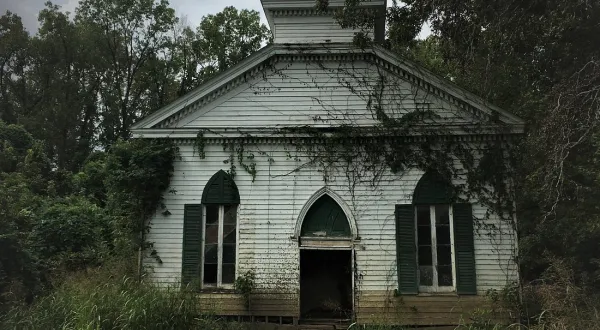The United States is dotted with abandoned towns, remnants of once-thriving communities that now stand as silent witnesses to the passage of time. These ghost towns capture our imagination, offering a glimpse into a past filled with promise and progress, now halted and preserved in a state of arrested decay. Among these forgotten places is a little-known town in Mississippi, a place that holds stories of prosperity, hardship, and ultimate abandonment. Exploring such a town not only satisfies our curiosity but also connects us to the rich tapestry of history that shaped our nation.
Historical Background
This Article Includes
Nestled in the heart of Mississippi, the town of Rodney once flourished as a bustling river port. Founded in the early 19th century, Rodney quickly became a vital hub for trade and commerce along the Mississippi River. Its strategic location made it a key player in the cotton trade, attracting merchants, farmers, and entrepreneurs from far and wide. By the 1850s, Rodney boasted a population of nearly 4,000 residents, complete with churches, schools, and businesses that catered to the needs of its growing community.
However, the tides of fortune began to shift for Rodney. The Civil War brought significant upheaval, disrupting trade and causing widespread damage. The town’s decline was further accelerated by a series of natural disasters. In 1863, a devastating flood altered the course of the Mississippi River, diverting it away from Rodney and leaving the town without its lifeline. Despite efforts to recover, Rodney never regained its former glory, and by the early 20th century, it was largely abandoned.
The Town’s Features and Landmarks
Today, Rodney stands as a testament to a bygone era, its streets and buildings echoing the stories of its past. Walking through the town, visitors can still see the remnants of its once-grand architecture. The Rodney Presbyterian Church, built in 1831, remains one of the most iconic structures, its Greek Revival style a reminder of the town’s prosperity. Despite its age, the church stands remarkably intact, a stark contrast to the decay surrounding it.
Another notable landmark is the Rodney Baptist Church, constructed in 1850. Although in a state of disrepair, the church’s Gothic Revival design and tall spire evoke the town’s rich architectural heritage. The former Masonic Lodge, now a shell of its former self, hints at the town’s once-thriving social life. These buildings, along with the scattered ruins of homes and businesses, offer a hauntingly beautiful glimpse into Rodney’s past.
Personal Stories and Anecdotes
The story of Rodney is not just one of buildings and commerce but also of the people who lived there. One notable resident was the Reverend Zebulon Butler, a prominent figure in Rodney’s religious community. His sermons were known to draw large crowds, and his influence extended beyond the pulpit. Tales of his dedication and kindness still resonate with those who study the town’s history.
Visitors to Rodney often share their own experiences, adding layers to its rich tapestry of stories. Historians recount tales of Union and Confederate soldiers passing through the town during the Civil War, leaving behind artifacts and stories of conflict. Modern-day explorers speak of the eerie yet captivating atmosphere, where nature has begun to reclaim the land, weaving vines through the crumbling masonry.
The Process of Abandonment
Rodney’s decline was a slow and multifaceted process. The economic impact of the Civil War was profound, as the town struggled to rebuild amidst the destruction. The alteration of the Mississippi River’s course dealt a severe blow, cutting off the primary trade route and isolating the town. Attempts to revive Rodney through agriculture and railroads were met with limited success, as larger cities with better infrastructure drew away potential investors and residents.
Environmental factors also played a role in Rodney’s abandonment. Frequent flooding and poor soil quality made agriculture increasingly difficult. Additionally, changes in transportation routes, particularly the rise of railroads, diminished the town’s importance as a river port. By the early 20th century, many of Rodney’s residents had moved on, seeking opportunities elsewhere.
Current State of the Town
Today, Rodney is a shadow of its former self, but its historical significance remains undiminished. The town’s remaining structures, though weathered by time, offer a poignant glimpse into the past. Efforts have been made to preserve what is left of Rodney, with historical societies and local volunteers working to maintain the integrity of its buildings.
For those interested in visiting, Rodney is accessible, though not without challenges. The roads leading to the town can be rough, particularly after rain, and visitors are advised to plan accordingly. Despite these obstacles, Rodney attracts history enthusiasts, photographers, and those simply seeking to experience a piece of Mississippi’s past.
Conclusion
Rodney, Mississippi, is more than just an abandoned town; it is a chapter in the larger story of America’s development. Its rise and fall reflect the broader economic, social, and environmental forces that have shaped our nation. Preserving places like Rodney allows us to connect with our history, understand the challenges faced by past generations, and appreciate the resilience of communities.
Exploring Rodney offers a unique opportunity to step back in time, to walk the same streets and enter the same buildings that were once filled with life and activity. As we continue to uncover and share the stories of such places, we not only honor the memory of those who came before us but also enrich our own understanding of the world. So, if you find yourself drawn to the mysteries of the past, consider a visit to Rodney—a town that, though abandoned, still has much to tell.










